Related Research Articles
Combinatorics is an area of mathematics primarily concerned with counting, both as a means and an end in obtaining results, and certain properties of finite structures. It is closely related to many other areas of mathematics and has many applications ranging from logic to statistical physics and from evolutionary biology to computer science.

Mathematics is an area of knowledge that includes such topics as numbers, formulas and related structures (algebra), shapes and the spaces in which they are contained (geometry), and quantities and their changes.

Number theory is a branch of pure mathematics devoted primarily to the study of the integers and integer-valued functions. German mathematician Carl Friedrich Gauss (1777–1855) said, "Mathematics is the queen of the sciences—and number theory is the queen of mathematics." Number theorists study prime numbers as well as the properties of mathematical objects made out of integers or defined as generalizations of the integers.
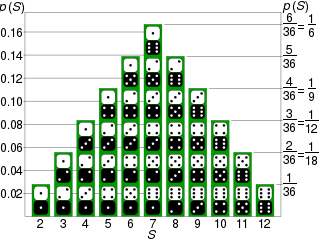
Probability is the branch of mathematics concerning numerical descriptions of how likely an event is to occur, or how likely it is that a proposition is true. The probability of an event is a number between 0 and 1, where, roughly speaking, 0 indicates impossibility of the event and 1 indicates certainty. The higher the probability of an event, the more likely it is that the event will occur. A simple example is the tossing of a fair (unbiased) coin. Since the coin is fair, the two outcomes are both equally probable; the probability of "heads" equals the probability of "tails"; and since no other outcomes are possible, the probability of either "heads" or "tails" is 1/2.
Probability theory is the branch of mathematics concerned with probability. Although there are several different probability interpretations, probability theory treats the concept in a rigorous mathematical manner by expressing it through a set of axioms. Typically these axioms formalise probability in terms of a probability space, which assigns a measure taking values between 0 and 1, termed the probability measure, to a set of outcomes called the sample space. Any specified subset of the sample space is called an event. Central subjects in probability theory include discrete and continuous random variables, probability distributions, and stochastic processes . Although it is not possible to perfectly predict random events, much can be said about their behavior. Two major results in probability theory describing such behaviour are the law of large numbers and the central limit theorem.
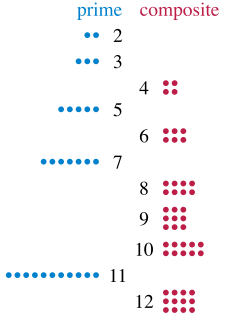
A prime number is a natural number greater than 1 that is not a product of two smaller natural numbers. A natural number greater than 1 that is not prime is called a composite number. For example, 5 is prime because the only ways of writing it as a product, 1 × 5 or 5 × 1, involve 5 itself. However, 4 is composite because it is a product in which both numbers are smaller than 4. Primes are central in number theory because of the fundamental theorem of arithmetic: every natural number greater than 1 is either a prime itself or can be factorized as a product of primes that is unique up to their order.
Statistics is a field of inquiry that studies the collection, analysis, interpretation, and presentation of data. It is applicable to a wide variety of academic disciplines, from the physical and social sciences to the humanities; it is also used and misused for making informed decisions in all areas of business and government.
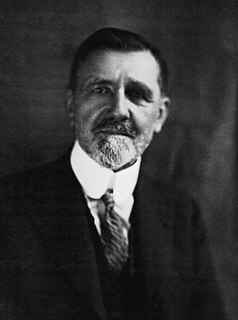
Félix Édouard Justin Émile Borel was a French mathematician and politician. As a mathematician, he was known for his founding work in the areas of measure theory and probability.

Information geometry is an interdisciplinary field that applies the techniques of differential geometry to study probability theory and statistics. It studies statistical manifolds, which are Riemannian manifolds whose points correspond to probability distributions.

Joseph Leo Doob was an American mathematician, specializing in analysis and probability theory.
In mathematics, Probabilistic number theory is a subfield of number theory, which explicitly uses probability to answer questions about the integers and integer-valued functions. One basic idea underlying it is that different prime numbers are, in some serious sense, like independent random variables. This however is not an idea that has a unique useful formal expression.
In number theory, Maier's theorem is a theorem about the numbers of primes in short intervals for which Cramér's probabilistic model of primes gives a wrong answer.
The Turán–Kubilius inequality is a mathematical theorem in probabilistic number theory. It is useful for proving results about the normal order of an arithmetic function. The theorem was proved in a special case in 1934 by Pál Turán and generalized in 1956 and 1964 by Jonas Kubilius.
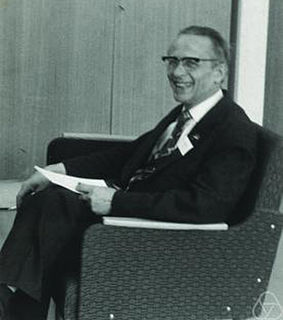
Jonas Kubilius was a Lithuanian mathematician who worked in probability theory and number theory. He was rector of Vilnius University for 32 years, and served one term in the Lithuanian parliament.
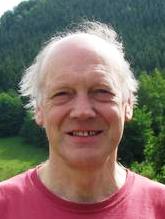
Geoffrey Richard GrimmettOLY is a mathematician known for his work on the mathematics of random systems arising in probability theory and statistical mechanics, especially percolation theory and the contact process. He is the Professor of Mathematical Statistics in the Statistical Laboratory, University of Cambridge, and was the Master of Downing College, Cambridge, from 2013 to 2018.
Probability has a dual aspect: on the one hand the likelihood of hypotheses given the evidence for them, and on the other hand the behavior of stochastic processes such as the throwing of dice or coins. The study of the former is historically older in, for example, the law of evidence, while the mathematical treatment of dice began with the work of Cardano, Pascal, Fermat and Christiaan Huygens between the 16th and 17th century.

Mathematics is a field of study that investigates topics such as number, space, structure, and change.
Mathematics is a broad subject that is commonly divided in many areas that may be defined by their objects of study, by the used methods, or by both. For example, analytic number theory is a subarea of number theory devoted to the use of methods of analysis for the study of natural numbers.
Gennadiy Mykhailovych Feldman is a Soviet and Ukrainian mathematician, corresponding member of the National Academy of Sciences of Ukraine, doctor of physical and mathematical sciences, professor, Head of the Mathematical Division of B. Verkin Institute for Low Temperature Physics and Engineering of the National Academy of Sciences of Ukraine.
References
- ↑ Schwarz, W. (1994). "Some aspects of the development of probabilistic number theory". In Grigelionis, B.; Kubilius, J.; Pragarauskas, H.; Statulevičius, V. (eds.). Probability theory and mathematical statistics: Proceedings of the 6th International Conference held in Vilnius, June 28–July 3, 1993. Vilnius: TEV. pp. 661–701. MR 1649606.; see p. 674
- ↑ "MATEMATIKA LIETUVOS MOKSLŲ AKADEMIJOJE" . Retrieved 14 April 2018.
- ↑ J.Kubilius Probabilistic methods in the Theory of Numbers at Google Books
- ↑ Manstavičius, Eugenijus; Schweiger, Fritz, eds. (1992). Analytic and probabilistic methods in number theory. New Trends in Probability and Statistics. Vol. 2. Utrecht: VSP. ISBN 978-90-6764-094-7 . Retrieved 2009-04-17.